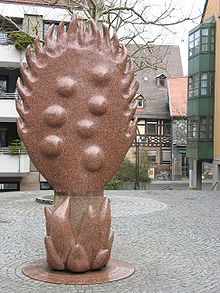History of the Jews in Fürth
The history of the Jews in Fürth has been attested since the 15th century.
Middle Ages and Modern Times
Jewish moneylenders are mentioned around 1440. They were later banned from the city, but in 1528 Jews were again allowed to settle in the city. In 1582 there were 200 Jewish residents. In 1607 a rabbi is mentioned. The Fürth Jews were represented in the city council by two community leaders. During the Thirty Years' War the community was reduced, but again enlarged in 1670 by newcomers who had been driven out of Vienna . At that time the center was in Geleitsgasse and several synagogues were built: in 1617 the old synagogue on Königstraße, in 1697 a new synagogue and in 1707 a family synagogue of the Fränkel family. The first cemetery was established in 1607, and a poor and hospital ( Hekdesch ) in 1653.
In 1719, Lothar Franz von Schönborn , Prince-Bishop of Bamberg, regulated the status of the community , which at that time consisted of 400 households. In return for payment of an annual fee, the Jews were guaranteed protection of life and property, the right to build synagogues, and permission to employ a cantor , school tapper and grave digger. Disputes among Jews came before a Jewish court , the during clashes between Jews and Christians church court were to decide. Community affairs were governed by a series of Takkanot in 1728 . The first Jewish orphanage in Germany was built in 1763 , and from the 17th century to 1824 there was an important yeshiva here , which was visited by young Mayer Amschel Rothschild and Luitpold Baumblatt , among others . The last headmaster was Wolf Hamburg , with whom the rabbis Hirsch Aub , Joseph Aub , Seligmann Bär Bamberger , David Einhorn , Marx Hayum Seligsberg , Leopold Stein and Bernhard Wechsler learned. In 1862 an Orthodox elementary school was built, which was officially recognized by the state in 1899. In 1811 Elkan Henle from Fürth published his work On the Constitution of the Jews in the Kingdom of Baiern and the Improvement of it for the Benefit of the State , which he dedicated to Maximilian von Montgelas . David Morgenstern was the first Jew to be elected to the Bavarian Chamber of Deputies in the December 1848 elections.
Hebrew printing began in Fürth in 1691 by the Schneur and Hirsch Frankfurter family, who published a total of 44 books, including a Sifra with commentaries. After Hebrew books were confiscated in 1702, this line of business was resumed in 1722 and flourished well into the 19th century.
19th century until today
According to the regulations of the Bavarian Jewish edict of 1813 , the Fürth district rabbinate was established around this time . From the 19th century to 1933, the Jewish community in Fürth was the largest in Bavaria. After the death of Rabbi Salomon Kohn , an advocate of Orthodox Judaism , Reform Judaism gained influence in Fürth.
In 1720, 1,500 Jews were counted in Fürth, in 1816 2,434 (19% of the total population), in 1880 3,336 and in 1933 2000 (2.6% of the total population). In 1904, the Fürth entrepreneur Heinrich Berolzheimer founded the Berolzheimerianum , the seat of today's Comedy Fürth . In 1906 the New Jewish Cemetery was inaugurated, on which a memorial for the Jewish fallen was erected after the First World War . 1933–1941 1400 Jews managed to leave Fürth. Most of them, including Henry Kissinger , ended up in the United States and some in Shanghai . During the “ Poland Action ” on October 28, 1938, 54 Polish Jews were deported from Fürth to Poland. On November 10, 1938 , the main synagogue was burned down, another six synagogues and countless Jewish shops and houses were devastated. Jews from Fürth were detained in the Sahlmannvilla , and 150 men were deported to Dachau . Until May 17, 1939, 785 Jews remained in Fürth. The further extermination of the community took place in three phases: on November 28, 1941, 28 Jews were brought to the Riga Ghetto , on March 24, 1942, 224 to Izbica , a transit station to Belzec , and on September 10, 1942, 153 Jews and children, mostly older, were transferred deported to Theresienstadt .
After the Second World War , around 40 Jews returned to Fürth. A synagogue was restored and rededicated. In 1970, 200 Jews lived in the city, in 1989 179. With the collapse of the Soviet Union , several hundred emigrants from CIS countries came to Fürth, in 2003 the membership of the community was 587. Fürth is the main location of the Jewish Museum Franconia , which opened in 1997 , with branches in Schnaittach and Schwabach .
See also
Individual evidence
- ↑ Christine Bartholomäus: Dr. Fischel Arnhem . In: Society for Christian-Jewish Cooperation Bayreuth (ed.): Jüdisches Bayreuth . Ellwanger, Bayreuth 2010, ISBN 978-3-925361-81-4 , pp. 106 .
- ↑ Berolzheimerianum Tourist Information Fürth
- ↑ Committee for the Commemoration of the Shoah Victims of Fürth (edited by Gisela Naomi Blume): Memor book for the memory of the Jews of Fürth murdered by the Nazis. Fürth 1997. p. 14.
literature
- Zeev Wilhelm Falk, Michael Berenbaum and Larissa Daemmig: Fuerth in: Encyclopaedia Judaica , 2nd edition 2007, Vol. 7, pp. 306-307.
- Gisela Naomi Blume: The Israelite orphanage in Fürth. In: Fürther Geschichtsblätter, issue 3/2010, pp. 59–86.
Web links
- Fürth - the Franconian Jerusalem Tourist Information Fürth
- 3D model of the school yard . Jewish Museum Franconia.
- History of the Jews in Nuremberg and Fürth by Hugo Barbeck, Verlag Friedrich Heerdegen (Barbeck), 1878, free download
